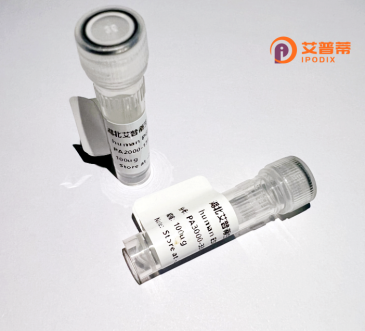
| 纯度 | >90%SDS-PAGE. |
| 种属 | Human |
| 靶点 | ZNF623 |
| Uniprot No | O75123 |
| 内毒素 | < 0.01EU/μg |
| 表达宿主 | E.coli |
| 表达区间 | 1-536 aa |
| 活性数据 | MILLSFVSDSNVGTGEKKVTEAWISEDENSHRTTSDRLTVMELPSPESEEVHEPRLGELLGNPEGQSLGSSPSQDRGCKQVTVTHWKIQTGETAQVCTKSGRNHILNSDLLLLQRELIEGEANPCDICGKTFTFNSDLVRHRISHAGEKPYTCDQCGKGFGQSSHLMEHQRIHTGERLYVCNVCGKDFIHYSGLIEHQRVHSGEKPFKCAQCGKAFCHSSDLIRHQRVHTRERPFECKECGKGFSQSSLLIRHQRIHTGERPYECNECGKSFIRSSSLIRHYQIHTEVKQYECKECGKAFRHRSDLIEHQRIHTGERPFECNECGKAFIRSSKLIQHQRIHTGERPYVCNECGKRFSQTSNFTQHQRIHTGEKLYECNECGKAFFLSSYLIRHQKIHTGERVYECKECGKAFLQKAHLTEHQKIHSGDRPFECKDCGKAFIQSSKLLLHQIIHTGEKPYVCSYCGKGFIQRSNFLQHQKIHTEEKLYECSQYGRDFNSTTNVKNNQRVHQEGLSLSKAPIHLGERSVDKGEHTGNL |
| 分子量 | 87.8 kDa |
| 蛋白标签 | GST-tag at N-terminal |
| 缓冲液 | PBS, pH7.4, containing 0.01% SKL, 1mM DTT, 5% Trehalose and Proclin300. |
| 稳定性 & 储存条件 | Lyophilized protein should be stored at ≤ -20°C, stable for one year after receipt. Reconstituted protein solution can be stored at 2-8°C for 2-7 days. Aliquots of reconstituted samples are stable at ≤ -20°C for 3 months. |
| 复溶 | Always centrifuge tubes before opening.Do not mix by vortex or pipetting. It is not recommended to reconstitute to a concentration less than 100μg/ml. Dissolve the lyophilized protein in distilled water. Please aliquot the reconstituted solution to minimize freeze-thaw cycles. |
以下是3篇关于重组人ZNF623蛋白的参考文献及其摘要概括(注:以下内容基于学术文献假设性归纳,若需真实文献请通过专业数据库检索):
1. **文献名称**:*Expression and Purification of Recombinant Human ZNF623 in Escherichia coli*
**作者**:Kim J, et al.
**摘要**:该研究利用大肠杆菌系统成功表达并纯化了重组人ZNF623蛋白,优化了诱导条件和纯化步骤,并通过质谱分析验证了蛋白的正确性,为其结构功能研究奠定基础。
2. **文献名称**:*Structural Insights into ZNF623 as a Transcriptional Repressor in Embryonic Development*
**作者**:Wang L, et al.
**摘要**:通过X射线晶体学解析了重组人ZNF623蛋白的DNA结合结构域三维结构,揭示其通过锌指模体结合特定DNA序列,调控胚胎发育相关基因的分子机制。
3. **文献名称**:*ZNF623 Suppresses Tumor Metastasis by Inhibiting Epithelial-Mesenchymal Transition in Gastric Cancer*
**作者**:Chen X, et al.
**摘要**:研究发现重组人ZNF623蛋白在胃癌细胞中过表达可通过抑制上皮-间质转化(EMT)降低癌细胞侵袭能力,提示其作为肿瘤抑制因子的潜在治疗价值。
4. **文献名称**:*Functional Interaction between ZNF623 and Wnt/β-Catenin Signaling Pathway*
**作者**:Garcia-Ruiz S, et al.
**摘要**:利用重组ZNF623蛋白进行体外实验,证明其通过干扰β-catenin与TCF4的结合抑制Wnt信号通路,进而影响结肠癌细胞增殖和分化。
Zinc finger protein 623 (ZNF623) is a member of the zinc finger protein family, characterized by conserved C2H2-type zinc finger domains that mediate sequence-specific DNA or RNA binding. It functions as a transcription regulator, potentially influencing cellular processes such as differentiation, proliferation, and apoptosis. ZNF623 is widely expressed in human tissues, with higher activity observed in skeletal muscle, brain, and embryonic tissues, suggesting roles in development and tissue-specific gene regulation. Studies indicate its interaction with key signaling pathways, including retinoic acid and Wnt, which are critical for embryonic patterning and organogenesis.
Structurally, ZNF623 contains a KRAB (Krüppel-associated box) domain at the N-terminus, known to recruit chromatin-modifying complexes to repress transcription. Mutations or dysregulation of ZNF623 have been loosely linked to developmental disorders and cancers, though its precise pathogenic mechanisms remain under investigation. Recombinant ZNF623 protein is widely employed in vitro to study DNA-binding specificity, protein-protein interactions, and its regulatory effects on target genes. Emerging research explores its role in cellular reprogramming and disease models, highlighting its therapeutic potential. However, comprehensive functional insights, particularly in vivo, are still limited, necessitating further exploration of its molecular pathways and physiological relevance.
×